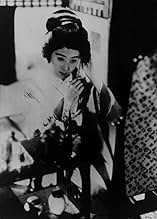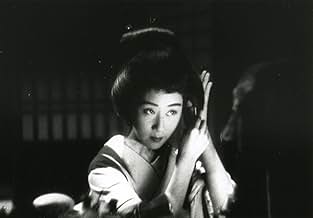Gion no kyôdai
- 1936
- 1 घं 9 मि
IMDb रेटिंग
7.4/10
3.2 हज़ार
आपकी रेटिंग
अपनी भाषा में प्लॉट जोड़ेंTwo geisha sisters lead a hard life in the Gion district of Kyoto. After one of them feels obliged to support a bankrupt businessman, the other sister sets up various schemes to get rid of h... सभी पढ़ेंTwo geisha sisters lead a hard life in the Gion district of Kyoto. After one of them feels obliged to support a bankrupt businessman, the other sister sets up various schemes to get rid of him.Two geisha sisters lead a hard life in the Gion district of Kyoto. After one of them feels obliged to support a bankrupt businessman, the other sister sets up various schemes to get rid of him.
- निर्देशक
- लेखक
- स्टार
- पुरस्कार
- कुल 1 जीत
Namiko Kawashima
- Oemi Furusawa
- (as Kazuko Kuno)
Fumio Ôkura
- Jurakudo, the antiques dealer
- (as Fumio Okura)
फ़ीचर्ड समीक्षाएं
Mizoguchi creates a tiny universe with a few characters that somehow manages to maintain in balance throughout the entire film. This is achieved because every character feels real, that means they can be right and wrong and there is not a single character that has the absolute truth.
Very simple filmmaking precisely thought out. With no ostentation the director decides to stay in the shade and put the story and characters in the spotlight.
After watching It on DVD a couple of years ago, I got to see It on the big screen thanks to the Bilbao Art House Zinema.
After watching It on DVD a couple of years ago, I got to see It on the big screen thanks to the Bilbao Art House Zinema.
Umekichi, a geisha in the Gion district of Kyoto, feels obliged to help her lover Furusawa when he asks to stay with her after becoming bankrupt and leaving his wife. However her younger sister Omocha tells her she is wasting her time and money on a loser.
Here we have another film by Mizogucki looking at "fallen women", much like "Street of Shame" twenty years later, and to some degree "Osaka Elegy". But we also have a tale of the old and the new -- looking to the West and also sticking with tradition. This is especially interesting given the radical shift in Japanese culture after World War II.
I have not seen the remake and thus cannot compare them, but how do you top the work of Mizoguchi? You simply cannot.
Here we have another film by Mizogucki looking at "fallen women", much like "Street of Shame" twenty years later, and to some degree "Osaka Elegy". But we also have a tale of the old and the new -- looking to the West and also sticking with tradition. This is especially interesting given the radical shift in Japanese culture after World War II.
I have not seen the remake and thus cannot compare them, but how do you top the work of Mizoguchi? You simply cannot.
Master Mizogushi placed on screen two different kind of look of the gueishas's world, although they are sisters, the older is more wise and understanding about his position, the younger is more cold having in the men just a way to get an easy money, handling according her will, actually she hates them, along the movie the viewers will see two side of the street in two human being whose the life hurt too hard, nice piece of art of study of human nature!!!
Resume:
First watch: 2018 / How many: 1 / Source: DVD / Rating: 7.25
Resume:
First watch: 2018 / How many: 1 / Source: DVD / Rating: 7.25
In the early days of film writing "Sisters" was often cited as one of the great films EVER; it is probably right that this quiet, measured film is now not viewed as such.
Still, I found it held my interest easily and was effecting. The acting is admirable, and the sadness of the women's plight are expressed without sentiment. Well worth seeing; 8 out of 10.
Still, I found it held my interest easily and was effecting. The acting is admirable, and the sadness of the women's plight are expressed without sentiment. Well worth seeing; 8 out of 10.
When reviewing Kenji Mizoguchi's 'Sisters of the Gion', the first and foremost thing that I have to talk about is the film's portrayal of exploited women and their sorry plight. For a film made in 1936, the film is astonishingly progressive. Mizoguchi leaves no stone unturned in showing the viewer how tough the life of a geisha was. The men whom we see engage with the sisters Omocha and Umekichi, though played by different actors are made to look very similar appearance wise and I think that was a specific choice on the part of Mizoguchi. Mizoguchi's approach to telling this story has a distinct boldness to it with a hopelessness simmering underneath. The protagonist Omocha is not a submissive character whose pain and suffering is supposed to convey the message. Instead, she is a feisty pragmatic rebel who played the game the way it is without being obstructed by any sense of morality. The feminist message is supposed to be conveyed by the fact that even fighting the system isn't enough to escape the exploitation and the abuse. These women would still continue to be treated as commodities.
What struck me about Mizoguchi's direction and visual style is his meticulous use of space in a particular frame. He sits on a frame, there is very minimal editing and he uses tracking shots quite a bit. He uses the 'frame within a frame' composition(also found in Renoir's films) quite a bit by placing characters in the background while others being in the foreground and pretty much each and every one of these visual choices serves a thematic purpose, be it conveying the difference in mindsets of Omocha and Umekichi or showing a man being lured in by Omocha's manipulation,etc. Another thing I noticed is Mizoguchi's reluctance in using too many close-ups. The close-ups in the film are used very sparsely and economically.
Due to its runtime, the film is a little light on character development or backstory, but the nuanced nature of using visuals to tell a story really impressed me. It is clear in its agenda and Mizoguchi is bold enough to express his ideas with conviction.
What struck me about Mizoguchi's direction and visual style is his meticulous use of space in a particular frame. He sits on a frame, there is very minimal editing and he uses tracking shots quite a bit. He uses the 'frame within a frame' composition(also found in Renoir's films) quite a bit by placing characters in the background while others being in the foreground and pretty much each and every one of these visual choices serves a thematic purpose, be it conveying the difference in mindsets of Omocha and Umekichi or showing a man being lured in by Omocha's manipulation,etc. Another thing I noticed is Mizoguchi's reluctance in using too many close-ups. The close-ups in the film are used very sparsely and economically.
Due to its runtime, the film is a little light on character development or backstory, but the nuanced nature of using visuals to tell a story really impressed me. It is clear in its agenda and Mizoguchi is bold enough to express his ideas with conviction.
क्या आपको पता है
- ट्रिवियाDaiichi Studio went into bankruptcy following the poor commercial results of the film.
- कनेक्शनReferenced in Aru eiga-kantoku no shôgai (1975)
टॉप पसंद
रेटिंग देने के लिए साइन-इन करें और वैयक्तिकृत सुझावों के लिए वॉचलिस्ट करें
विवरण
- रिलीज़ की तारीख़
- कंट्री ऑफ़ ओरिजिन
- भाषा
- इस रूप में भी जाना जाता है
- Sisters of the Gion
- उत्पादन कंपनी
- IMDbPro पर और कंपनी क्रेडिट देखें
बॉक्स ऑफ़िस
- दुनिया भर में सकल
- $17,807
- चलने की अवधि
- 1 घं 9 मि(69 min)
- रंग
- पक्ष अनुपात
- 1.37 : 1
इस पेज में योगदान दें
किसी बदलाव का सुझाव दें या अनुपलब्ध कॉन्टेंट जोड़ें








